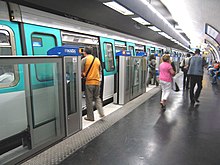Platform screen door
A platform screen door is a door embedded in partition walls between the route and the platform in train stations . Platform screen doors are used for the safety of passengers and are always closed when there is currently no train to be processed in the station or a train is due to pass through. After a retracted train has come to a standstill, they are opened together with the train doors for the purpose of changing passengers and closed again before the train departs.
Applications of platform screen doors
Platform screen doors are designed to prevent people from falling or objects from falling into the track area and suicide attempts , as well as reducing the noise of the trains entering and leaving the stations and keeping drafts away from the waiting passengers. Since platform screen doors (if extended to the ceiling) restrict drafts to the track area, air conditioning in the platform area is possible. The partition walls and the platform screen doors are often glazed so that passengers can see the incoming train and the train destination indicators attached to it.
Platform screen doors are mainly installed in busy stations with narrow platforms. The most common applications of platform screen doors are underground train stops and airport railroad stations in the terminal buildings. In order to enable the use of platform screen doors, the equipped platform may only be approached by trains of the same type or series with the same distances between the doors. In addition, the trains must be stopped very precisely at a defined stopping point so that the vehicle doors always come to a stop exactly in front of the platform screen doors. Platform screen doors enable trains to drive in and through faster, as there is no need to fear any risk to passengers near the platform edge (e.g. through suction and air turbulence).
Platform screen doors on automatic railways
Platform screen doors are often used in automatically (driverless) operated railways, as there is no driver there who can recognize passengers and objects who have fallen into the track and initiate emergency braking in the event of danger . In addition, automatic trains usually achieve better stopping accuracy, which in turn is indispensable for the use of platform screen doors so that the vehicle doors come to a stop congruently with the platform screen doors.
Examples of automatically operated railways with platform screen doors are the H-Bahn at the TU Dortmund (which also operates as SkyTrain at Düsseldorf Airport ), the SkyLine- Hochbahn at Frankfurt Airport , the Skymetro at Zurich Airport , lines 1 , 13 and 14 Métro Paris , Métro Lille , Métro Rennes , Copenhagen Metro and the people mover to the terminals at Stansted Airport . In Berlin , the M-Bahn stations were equipped with platform screen doors in the 1980s .
No platform screen doors were installed on the U2 and U3 lines of the Nuremberg U-Bahn , the first automatically operated U-Bahn lines in Germany.
Alternatives to platform screen doors
If you only want protection from people and objects on the track, instead of platform screen doors on automatic railways, security staff (such as the train chiefs on the Docklands Light Railway ), electronic systems (microwave barriers as on the U2 and U3 lines in Nuremberg ) can be used. or mechanically (step plates acting on a defined pressure as in the SkyTrain Vancouver or the Kelana Jaya Line in Kuala Lumpur) monitor the track area. In the event of danger, these systems cause approaching trains to brake quickly. Depending on the system, on routes with conductor rails arranged in the track area, these are also disconnected from the power supply in order to minimize further hazards.
These systems are cheaper than the installation of platform screen doors and also enable the use of vehicles with different door gaps, but do not represent a physical barrier to the track area and therefore only reach the safe state after the emergency braking of the approaching train has been completed.
Bus rapid transit
Aside from rail-bound transport systems, some Bus Rapid Transit (BRT) systems also use platform screen doors.
Web links
Individual evidence
- ^ Platform Screen Doors half-height, KABA
- ↑ Platform screen doors - a theoretical protection. Der Tagesspiegel, January 21, 2016, accessed on January 29, 2018 .
- ↑ Platform screen doors. Schaltbau Refurbishment GmbH, accessed on January 29, 2018 .
- ^ Brian Hardy: The Berlin U-Bahn . Capital Transport, Harrow Weald 1996, ISBN 1-85414-184-8 , pp. 24 .




